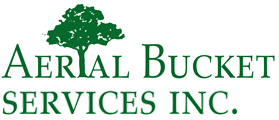Tree Pruning, Cutting & Trimming Service
There are ANSI standards for tree pruning & tree trimming. Our company follows these standards and according to the industry standards for tree pruning. Aerial Bucket Services estimators can provide recommendations based on the specific tree needs for our customers. Every tree is different and the goals for each customer and their trees vary. Our arborists have expert opinions and only recommend the best pruning methods for our customers trees.
There are many different types of tree pruning. Trees for the most part can take care of themselves, however, when people and trees come together – urban forestry, this is when tree pruning and maintenance is necessary.
Tree Pruning Methods
Crown Cleaning
Crown Cleaning a tree involves pruning the deadwood, diseased, and dying limbs out of the canopy of a tree. This type of pruning is extremely beneficial for the health and promotes longevity for a tree.
Crown Thinning
Crown Thinning a tree involves lightly pruning the interior limbs of at tree canopy. Generally, this is done to achieve more sunlight on a customer’s lawn, or to prevent storm damage. Lightly thinning the interior allows for wind flow to better flow through the canopy, thus reducing chances of limb failure in a storm. Usually it is recommended to only cut approximately 10-15% of the live growth in the interior, and to avoid lion tailing.
Crown Raising
Crown Raising a tree involves elevating or cutting the lower limbs of a tree canopy. This type of pruning is usually done to achieve visibility, or to allow lawn mowers to be able to mow grass underneath without a tree limb in the way, or anything else such as cars and people to be able to pass underneath the trees canopy.
Crown Reduce
Crown Reducing a tree involves lightly thinning out the top of a trees canopy. Do not mistake this for tree topping. Topping is NOT a recommended pruning method and should be avoided. A proper crown reduction will reduce the overall crown height and canopy, without altering branch integrity. This type of pruning minimized storm damage, and reduces the chances that larger taller trees from falling or uprooting in a storm.
Clearance Pruning
Clearance pruning a tree involves cutting a trees limbs away from a structure by a certain # of feet. Proper cuts should be made according to ANSI standards, always cut back to the nearest lateral growth, never cut in the middle or inter-node of a branch. Clearance pruning is usually done to clear houses, roofs, sheds, cars, and such of encroaching limbs.
Shaping
Shaping a trees canopy should really only be done on shrubs and bushes – not trees. Larger trees can be shaped but only by a selective prune with proper cuts – not topping. Small shrubs and bushes like Holly trees, bush hedges, and other shrubs and bushes can be shaped how you like them. Some green should always be left or the plant has been shaped to hard and faces the chance of declining. Hand shears are usually used when shaping is completed.
